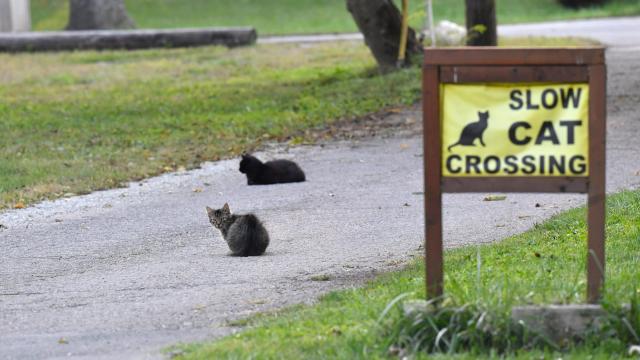New research shows the extent to which cats are likely driving the spread of a problematic brain parasite to wild animals and how the ongoing deterioration of our environment is making this problem even worse.
A study published in Proceedings of the Royal Society B: Biological Science connects densely populated urban areas with increased cases of Toxoplasma gondii among wild mammals. Domestic cats are common carriers of the parasite, and cats are often allowed to freely roam outside, so the researchers naturally suspect our feline friends as being the driving mechanism behind this process. Veterinarian and ecologist Amy Wilson from the University of British Columbia led the new research.
Toxoplasma gondii is a parasite that causes an upsettingly common infection known as toxoplasmosis, or toxo; it infects approximately one-third of the world’s population. The parasite is famous for altering the behaviour of mice, making them more susceptible to predation by cats. Once infected, a single cat can shed half-a-billion toxo eggs in just two weeks. These eggs, known as oocysts, are super resilient, capable of living in moist soil and water for a full year and possibly even longer.
Scientists refer to toxo as a generalist zoonotic parasite, which means it’s highly capable of living and spreading to all sorts of different animals. For toxo, this means it can make the leap to any warm-blooded animal, including birds and mammals. For healthy animals, a toxo infection shouldn’t be a problem, but when in the presence of a weakened immune system, the parasite goes into action, triggering all sorts of illnesses and death in some extreme cases. In humans, the disease is especially dangerous for pregnant people.
Going into the study, Wilson and her colleagues knew that toxo isn’t spread evenly among the world’s wild animals, but the processes driving this variation were not well understood. The new study was an attempt to fill this gap in our knowledge. To that end, the team analysed 45,079 documented cases of toxo in free-ranging wild mammal species. This data was pulled from 202 international studies and included 238 different mammalian species.
The connection became clear: Wildlife living near dense urban areas were more likely to be infected with toxo, and it didn’t matter where these animals were positioned within their respective food webs.
“As increasing human densities are associated with increased densities of domestic cats, our study suggests that free-roaming domestic cats — whether pets or feral cats — are the most likely cause of these infections,” Wilson explained in a press release. “This finding is significant because by simply limiting free roaming of cats, we can reduce the impact of Toxoplasma on wildlife.”
The researchers also noticed a higher prevalence of the parasite in warmer climates and among animals with aquatic diets. That animals living in aquatic ecosystems have increased exposure to toxo did not come as a surprise to the researchers, “due to the potential for substantial and localised oocyst influxes through runoff and increased exposure area through suspension through the water column,” as they wrote in their study.
Got a couple of caveats to point out, however.
The researchers didn’t have the desired global coverage, lacking data for central Eurasia and east-central Africa. That’s unfortunate, because ”countries on these continents have relatively high human T. gondii prevalence,” according to the paper. Also, the team would like to dive deeper into the various ecosystems studied, to get a more nuanced sense of where and how toxo might be spreading within the identified hotspots.
The paper identifies high-risk areas for wild animals to acquire a toxo infection, but as the researchers themselves admit, cause and effect was not firmly established; the scientists are merely inferring that cats are the primary drivers of the disease, which, to be fair, is probably a very good inference. Accordingly, “proactively targeting pathogen pollution from domestic cats would be the most pragmatic and impactful intervention for decreasing wildlife infections,” the authors write.
Ooh, that is such a good term: ‘pathogen pollution.’ That’s a nice way of describing the problem. We are literally polluting the environment with the toxo parasite by allowing some cats — a creature moulded by the processes of artificial selection and now reproducing to impossibly high numbers — to roam free. It’s well documented that domestic cats, when allowed to roam free, are an ecological menace, killing huge numbers of birds and other creatures; we can now add another item to the list, as likely spreaders of toxo to wildlife.
An important point made in the paper is that vibrant and healthy ecosystems are a natural defence mechanism against the spread of pathogens, toxo included.
“We know that when wetlands are destroyed or streams are restricted, we are more likely to experience runoff that carries more pathogens into the waters where wild animals drink or live,” Wilson said. “When their habitats are healthy, wildlife thrives and tends to be more disease-resistant,” she said, adding: “Conservation is really preventative medicine in action.”
